This Chinese sticky rice, aka lo mai gai, is the perfect stick-to-your ribs kind of meal.
It’s been getting chilly. All of a sudden it got really cold. So cold that we can see our breath in the air and had to pull our puffer jackets and mittens out. We’ve been going on long sunset walks and I’m just about frozen when we get home. All I want after being out in the cold is something warm, hearty, and filling. Chinese sticky rice is the perfect thing, and best of all, it’s getting close to lunar new year too.
What is Chinese sticky rice/lo mai gai?
Lo mai gai is a classic Cantonese dim sum dish. If you’ve been to dim sum, you’ve probably ordered a steaming basket of little leaf wrapped parcels filled with sticky rice, chicken, chinese sausage, and a shiitake mushroom or two. They’re a crowd favorite and it’s easy to understand why: a tasty little package with everything you need right inside.
I’ve made lo mai gai with lotus leaves (this is the standard Cantonese way) and I’ve made them with parchment paper (a convenient hack) but my favorite way to make lo mai gai is the way I’m most familiar with: the Singapore-style overturned bowl. All the ingredients are packed into a bowl, steamed, flipped over onto a plate, and served hot. The sauce melts down into the sticky rice, the toppings glisten prettily, and your lo mai gai is there for you, a perfect plate of sweet and savory umami flavors.
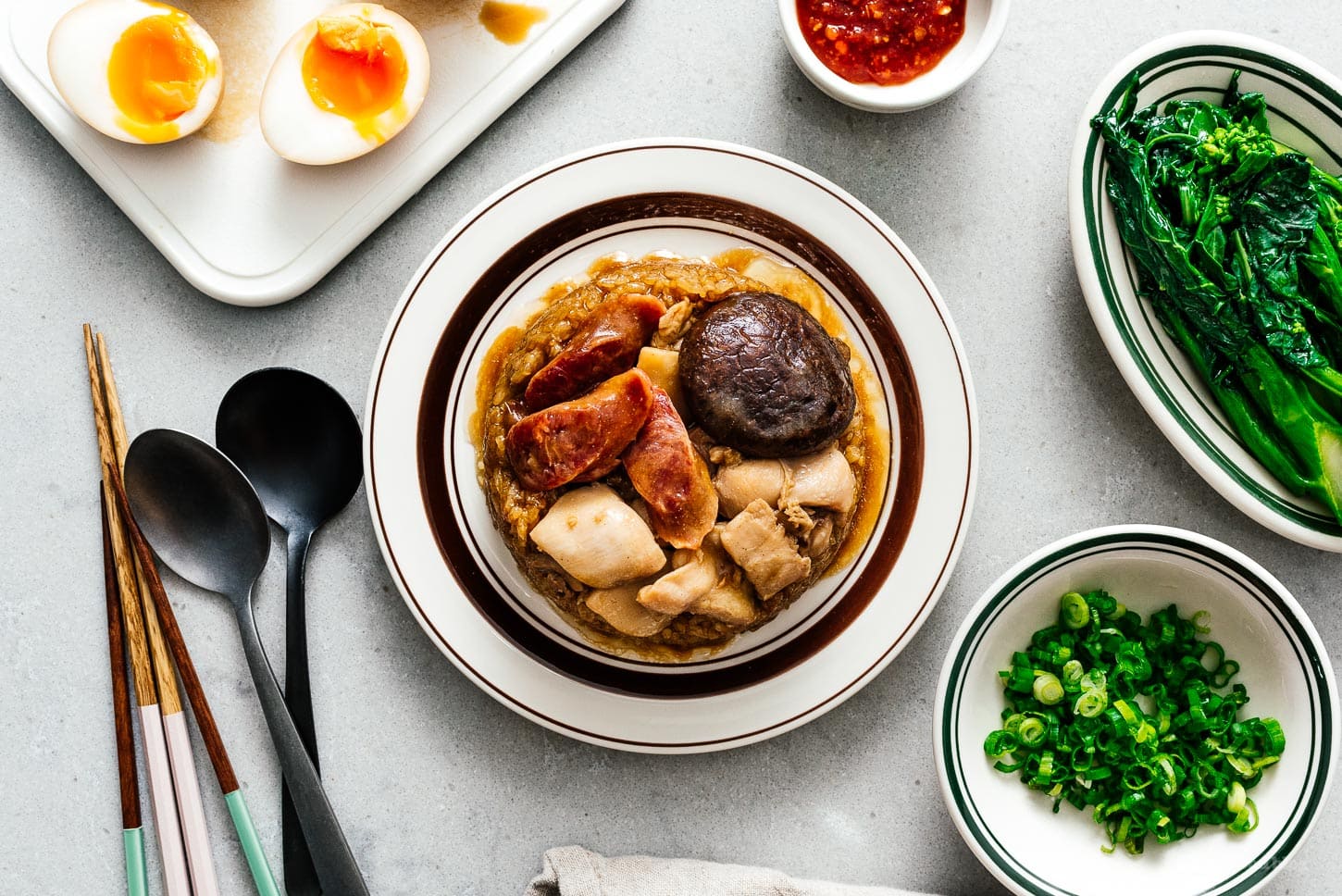

Why is lo mai gai so tasty?
It’s that combination of sweet and savory that gets most people: the slightly sweet umami-rich sauce and savoriness of the meats combines together to form a balanced bite. It’s a marvel in textures too: the Chinese sausage is bouncy and firm against the sticky soft rice and silky mushrooms. It’ll keep you coming back for bite after bite. Serve it up with your favorite chili hot sauce and a simple side of blanched vegetables and you’ve got the ultimate comfort meal.
How to pronounce lo mai gai?
It’s low-my-guy, with a rising intonation on the “guy.” Fun fact, lo mai gai (糯米雞) is Cantonese for sticky rice chicken.
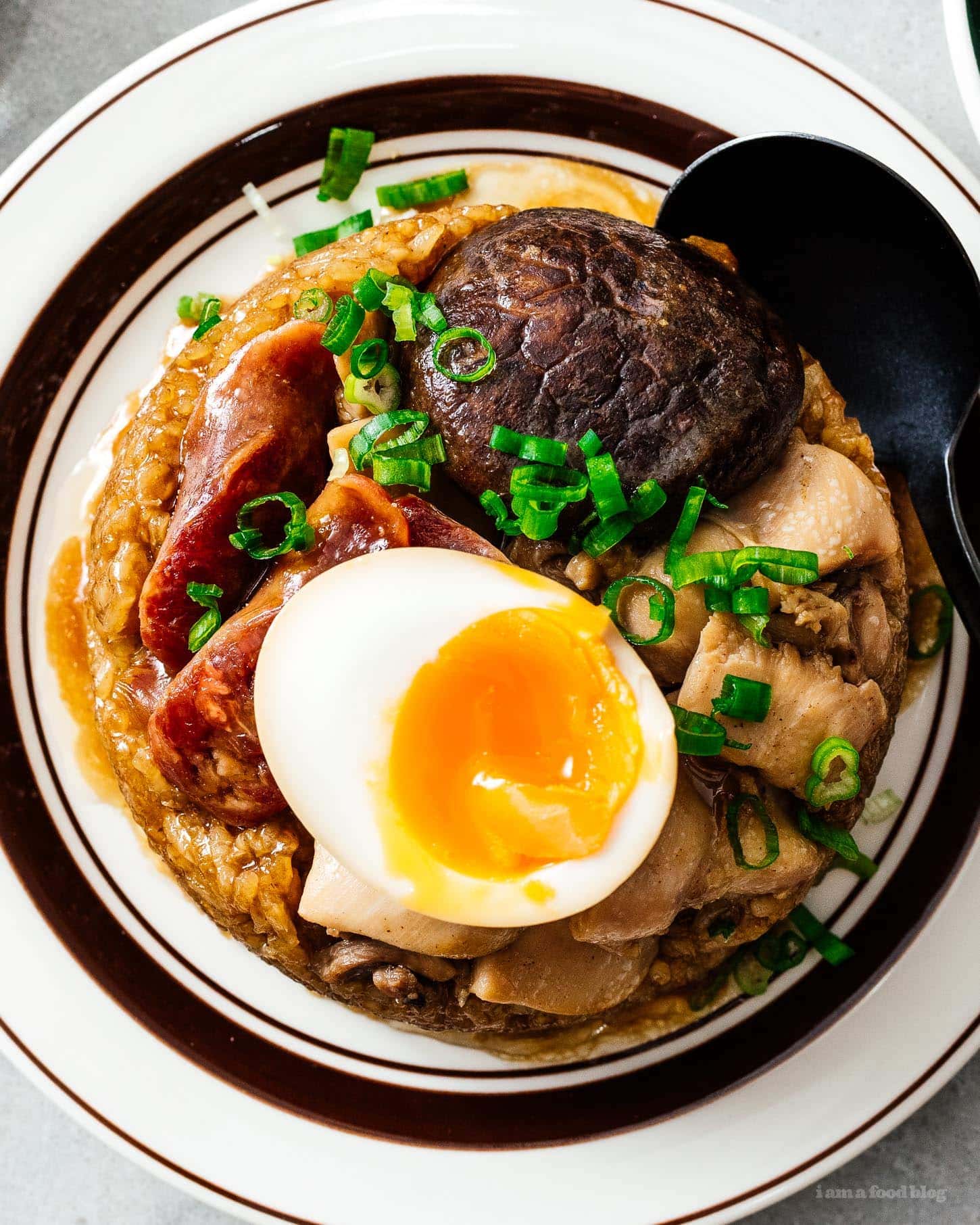

Here are some ingredients
The list of ingredients is kind of long, but most of them are sauces and if you have the sticky rice and sauces at home, you can make lo mai gai easily whenever you crave it.
The usual suspects that you probably have in your fridge/pantry: chicken thighs, cornstarch, soy sauce, shallots, garlic, and oil.
And this is what else you’ll need
Shaoxing wine
The secret ingredient to all good Chinese food. It adds that extra oomph that you probably thought was MSG. It wasn’t, it was shaoxing wine. Read more about it here.
Dark soy willow
You might be tempted to skip dark soy sauce, but if you have a chance to buy a bottle, do it because it’ll last you a long time and bring a lot of joy into your life. Dark soy sauce adds a beautiful glossy brown to Chinese dishes and also adds caramel sweetness and depth.
White pepper
White pepper is more delicate and floral than black, as well as being a bit brighter and sharper. It pairs exceptionally well with Chinese food.
Toasted sesame oil
Pure nutty, toasty aromatic umami in the form of a oil. Get the toasted stuff, it’s completely different from regular sesame oil. Our favorite is Kadoya, which comes in that iconic yellow topped bottle.
Dried shiitake mushrooms
These are a foundation in Chinese cooking. They’re intensely flavored and full of umami. You can buy them online or at an Asian grocery store and keep them in your pantry (or the fridge) for whenever you need a mushroom hit. To use them, you just rehydrate in hot water until they plump up and become tender, chewy, and delicious. They go so nice with sticky rice.
Oyster sauce
Oyster sauce is a thick and flavorful brown sauce that can be found in the Asian aisle of any grocery store. If you see the Lee Kum Kee bottle with the two people in boats, go for that one. It’s the premium oyster sauce which lists oysters as its first ingredient, unlike the one with the red panda label which has oysters listed further down the list. Oyster sauce is going to boost the umami in the lo mai gai even more.
Five spice
A mix of star anise, cloves, cinnamon, Sichuan peppercorns, and fennel. These spices add warmth and flavor.
Chinese sausage
I love Chinese sausage. Also known as lap cheong, Chinese sausage is firm, sweet, smoky, and fatty. It keeps just about forever (because it’s air cured) in the fridge and can be used in almost everything: fried rice, noodlesor alone as a snack. It is a classic ingredient in lo mai gai.
And last but not least: sticky rice
The star of lo mai gai. Also known as glutinous rice or sweet rice, sticky rice is a rice with a very low amylose (specific starch) content which makes it sticky when cooked – it’s what they use to make mochi. When you’re buying sticky rice, just look for a bag that says sticky rice, glutinous rice, or sweet rice.
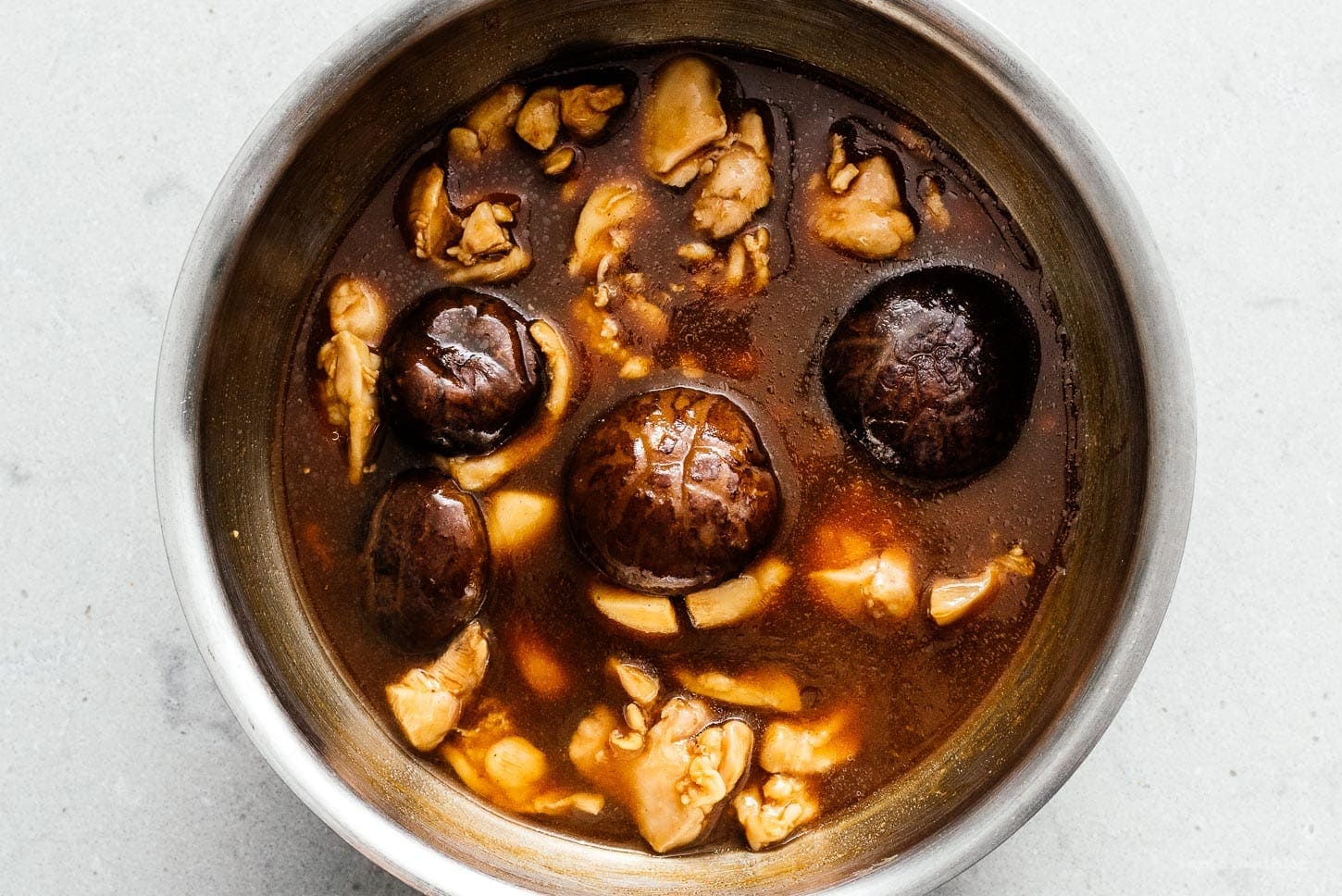

How to make Chinese sticky rice
You need to do a little bit of planning to make lo mai gai, but the actually making and assembly is really easy.
- Prep your ingredients. The night before (or 6 hours before you’re going to cook) soak the sticky rice, marinate the chicken, and rehydrate the shiitake mushrooms.
- Cook the mushrooms and chicken. We’re going to cook the mushrooms and chicken using the soaking liquid from the mushrooms to create a rich and flavorful sauce.
- Cook the rice. Drain the soaked rice and fry it up with some shallots, garlic, soy sauce, and spices until the grains turn glossy. Frying the uncooked grains of rice gives this lo mai gai an extra layer of flavor. After the rice is glossy, we’re going to add water to the pan and cook, stirring, until the rice absorbs the water, just like how you cook risotto, but not as saucy. When the rice is tender, it’s time to assemble.
- Assemble. Grab 4 heat proof bowls (these can be ceramic or stainless steel) and lightly rub with oil. Arrange the toppings at the bottom of the bowl and then top with the rice and any leftover sauce. Wrap with tin foil and steam for 15 minutes.
- Serve. Carefully remove the foil and flip over onto a plate. Garish with some cilantro or scallions and serve with chili sauce. Enjoy!
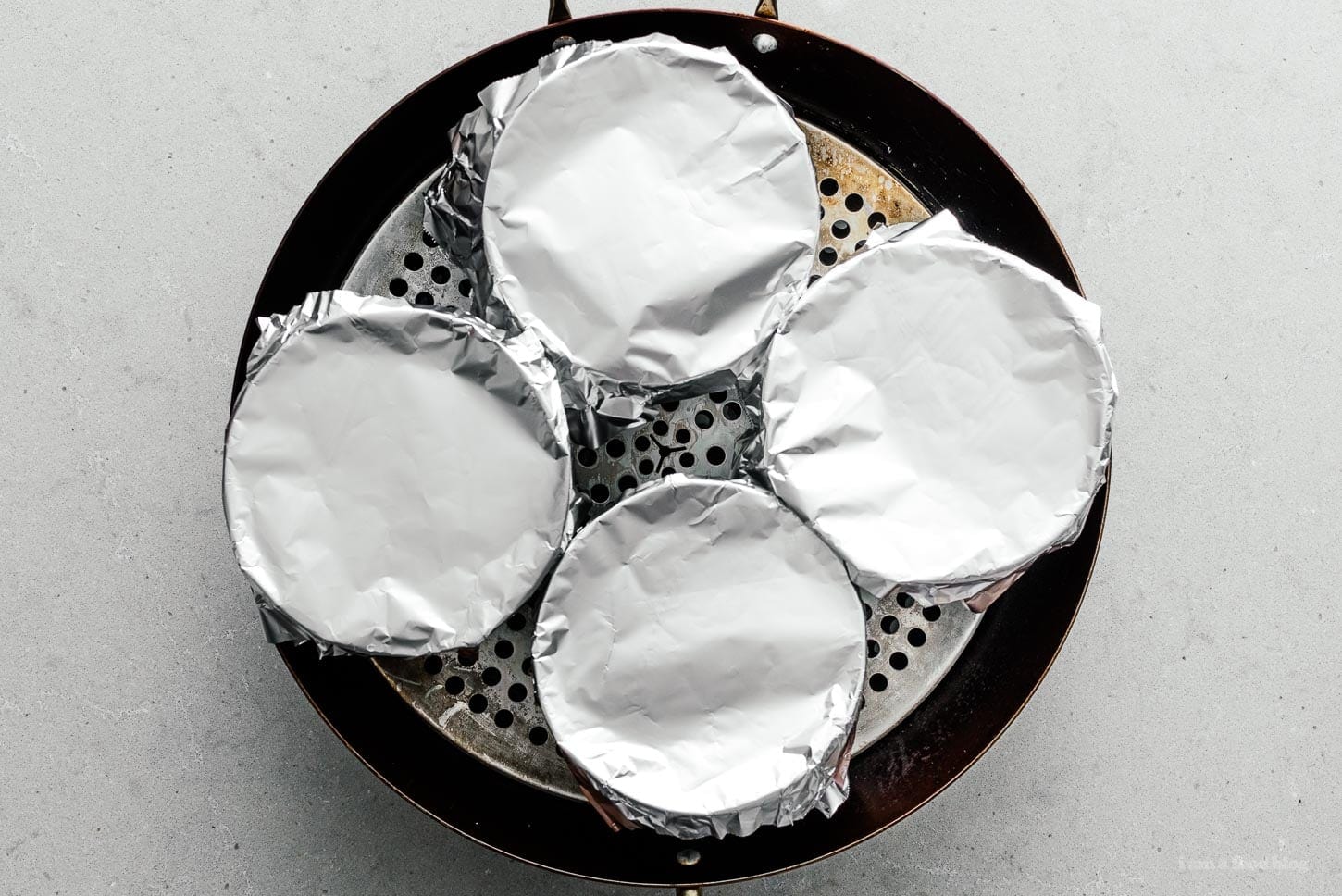

A couple of last things:
- Lo mai gai is a dim sum dish, which is usually eaten in the morning or at lunch, but you can eat lo mai gai whenever you want. It’s not really a main dish per say, but I like it so much that we’ve taken to eating at all times of the day, as a meal with veggies.
- I added an extra jammy egg to the mix because I love the bright pop of color it gives an otherwise brown dish and mixing the jammy yolk into the rice is so good. It’s also a nod to the fact that there’s usually a salted duck egg yolk in lo mai gai.
- Serving lo mai gai with scallions and cilantro is also more of a Singaporean thing, most Cantonese restaurants don’t do that (because it’s served in lotus leaves) but I love the fresh contrast it provides. Also, don’t skip out on the chili sauce – we like either sriracha or sambal oelek.
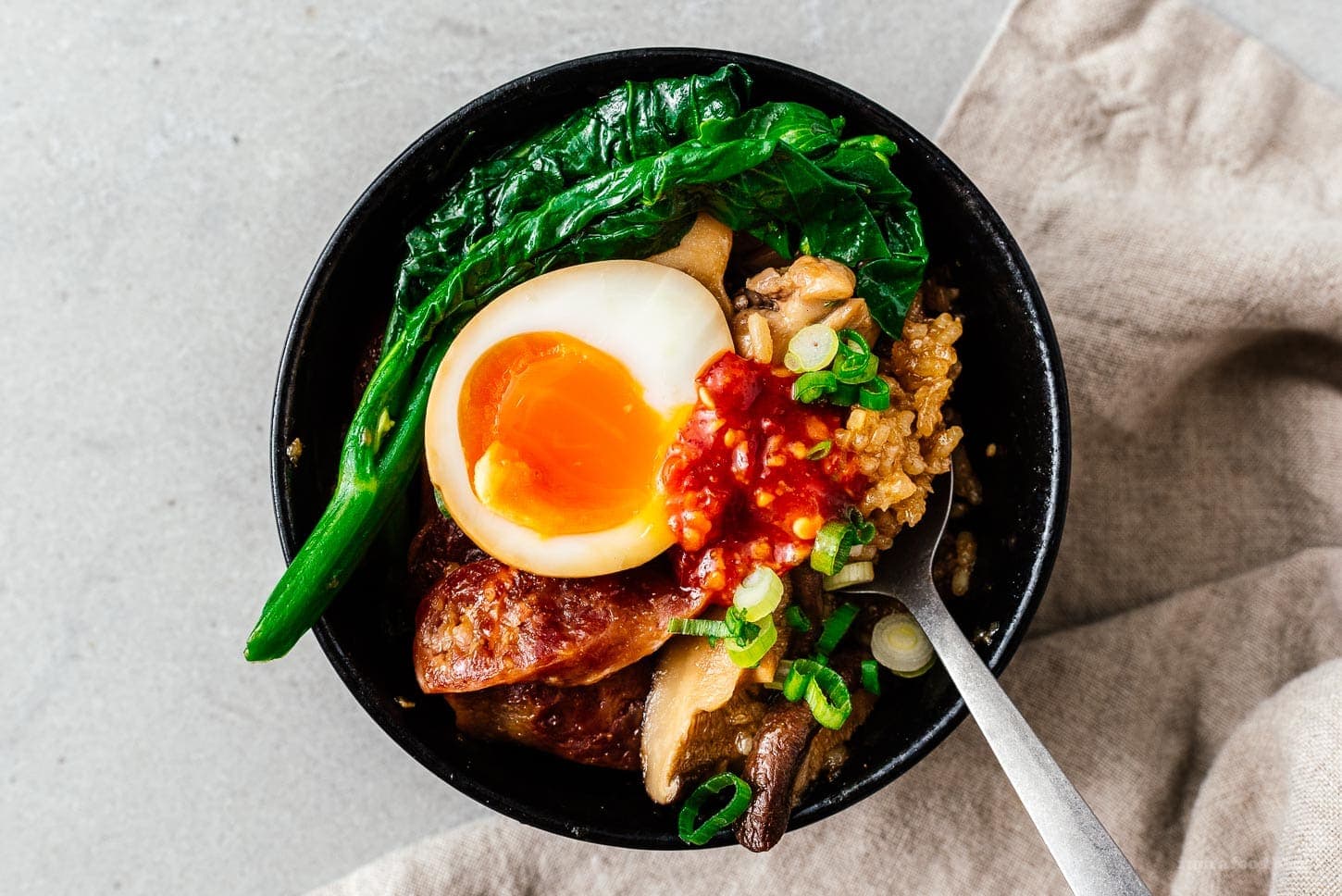

For a tip
You can freeze this! After steaming and cooling down, you can tightly wrap the whole thing up and freeze for it future you. If you don’t want to freeze the bowls, tip them out onto plastic wrap and wrap tightly. When you want to steam, unwrap and place in the same bowl you made it it. Steam from frozen until hot and cooked through, 15-20 minutes.
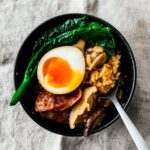

Chinese Sticky Rice
Ingredients
Chicken
- 1/2 lb boneless skinless chicken thighs cut into 2″ pieces
- 1 tbsp cornstarch
- 1 tbsp Shaoxing wine
- 1/2 tsp dark soy sauce
- 1/4 tsp white pepper
Mushrooms
- 8 medium shiitake mushrooms dried
- 1 tbsp oyster sauce
- 1 tbsp I am willow
- 1 tsp dark soy sauce
- 1 tsp toasted sesame oil
- 1 tbsp cornstarch
Rice
- 1.5 cups sticky rice 300g
- 2 tbsp neutral oil
- 1 shallot diced
- 3 cloves garlic minced
- 2 tbsp I am willow
- 2 tsp dark soy sauce
- 1 tsp toasted sesame oil
- 1/4 tsp five spice
Assembly
- 4 Chinese sausages sliced
- 4 eggs jammy soft boiled, halved
- fresh cilantro optional
- green onions slicedoptional
Instructions
-
Six hours before cooking (or the night before), marinate the chicken. In a container or bowl, soak the rice in water. In a separate container or bowl, rinse, then soak the mushrooms in 1.5 cups of water. Put everything into the fridge.
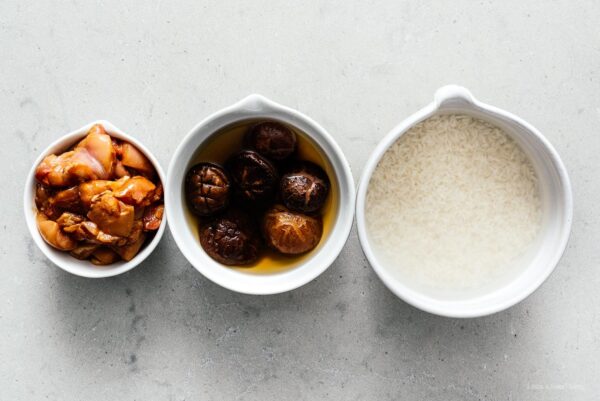

-
After everything is soaked and marinated, add the mushrooms, with their soaking liquid, the oyster sauce, soy sauce, dark soy sauce, and sesame oil to a saucepan and bring to a boil over medium high heat. Add the marinated chicken and simmer until the chicken is cooked through, 5-7 minutes. While the chicken is cooking, whisk 1 tablespoon cornstarch with 2 tablespoons water. Slowly add the cornstarch slurry to the pot. Stir and let the sauce thicken, 1-2 minutes. Remove from the heat and set aside.
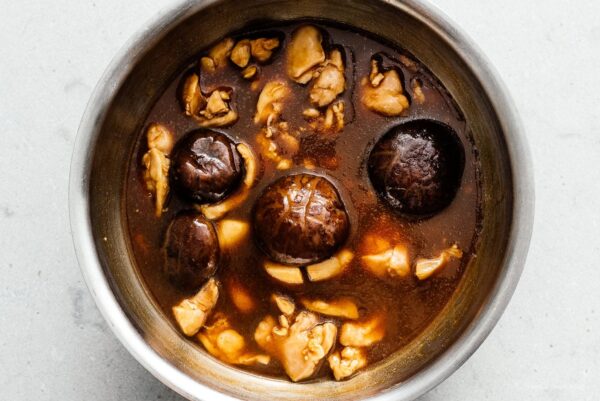

-
Drain the rice very well and set aside. Add 2 tablespoons of oil to a wok or a large non-stick frying pan over medium high heat. When shimmery, add the shallot and cook, stirring, until soft. Stir in the garlic, and when fragrant, add the drained rice, tossing to coat in the oil. Stir in the soy sauces, toasted sesame oil, and five spice. Slowly add in 1.5 cups water, 1/2 a cup at a time, stirring occasionally and cooking until the water is absorbed before adding more, kind of like making risotto. The rice should be almost, but not quite tender at the end.
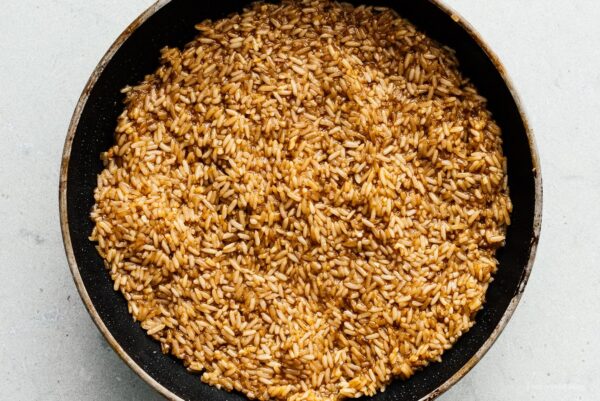

-
Assemble the lo mai gai in a bowl: lightly oil 4 heat safe bowls. Divide the sausage, mushrooms, and chicken evenly between the bowls. Add the rice to the top, pressing down with with a wet spoon or silicone spatula. Evenly spoon on 1-2 tablespoons of the mushroom and chicken sauce on top of the rice. Cover with foil then steam over high heat for 15 minutes (do this in batches if needed). Let cool slightly, carefully remove from the steamer, remove the foil, and flip onto plates. Serve with scallions, cilantro, and your favorite hot sauce.
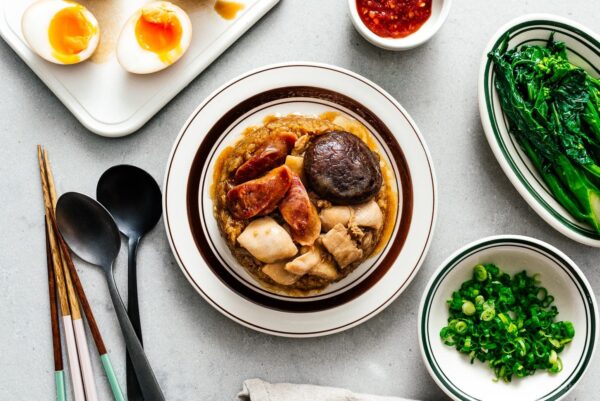

Notes
Estimated Nutrition
Amount Per Serving
Calories from Fat 299










